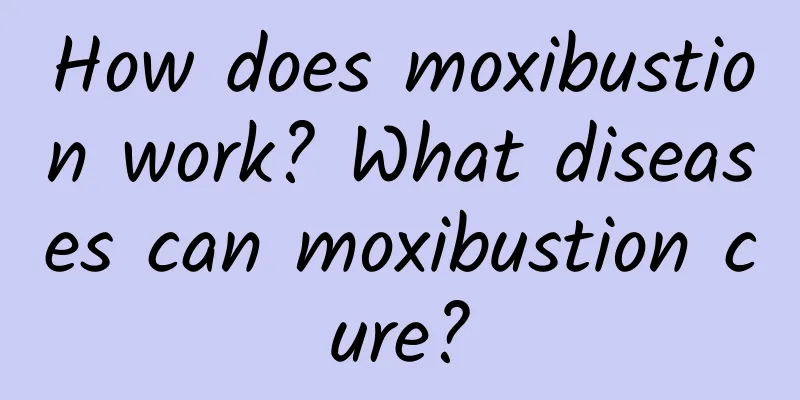How does moxibustion work? What diseases can moxibustion cure?

|
Moxibustion is one of the important therapies in traditional Chinese medicine. It is a method of treating diseases by using moxa leaves, which are dried, tanned, and impurity-removed to make moxa wool. After burning, it is used to fumigate the acupuncture points of the human body. So, how does moxibustion work? What diseases can moxibustion cure? Let's take a look at the introduction of Encyclopedia Knowledge Network! Contents of this article 1. How to perform moxibustion 2. What diseases can moxibustion cure? 3. Precautions for moxibustion 1How to perform moxibustionBasic tools for moxibustion Moxa cone: Made of moxa wool, it is cone-shaped. In moxibustion therapy, you can choose the appropriate size of moxa cone according to the needs of treatment. Generally speaking, larger moxa cones are used to moxibustion large areas of the body, such as the back and abdomen. Smaller moxa cones are used to moxibustion the limbs or head and face. In addition, children are suitable for using smaller moxa cones. When using moxa cones for moxibustion, place the moxa cone on the moxibustion site and light it. Basic methods of moxibustion Moxa stick: a stick-shaped moxibustion tool made of moxa coils. The quality of moxa sticks is mainly determined by the purity of the moxa. Generally, the grade of moxa is indicated on the packaging of moxa sticks. For example, if the moxa grade is 1:6, it means that 6 kilograms of moxa leaves are required to make 1 kilogram of moxa. The higher the grade, the higher the purity and the better the quality. When using moxa sticks for moxibustion, light the moxa sticks and use them to smoke the acupuncture points or affected areas. 2What diseases can moxibustion cure?1. Respiratory diseases, such as asthma, chronic bronchitis, chronic obstructive pulmonary disease and other chronic respiratory diseases, recurrent respiratory infections in remission (such as bronchitis, bronchopneumonia), etc. 2. Pediatric diseases, such as bronchitis, bronchial asthma, allergic rhinitis, chronic rhinitis, pharyngitis, recurrent colds and coughs, respiratory tract infections, etc. 3. Skin diseases, such as psoriasis, eczema aggravated in winter and summer, frostbite, keratotic tinea pedis, cold urticaria, and many beauty-damaging skin diseases such as acne, chloasma, recurrent facial dermatitis, cosmetic hormone dermatitis, etc. 4. Kidney disease: chronic nephritis, chronic renal failure, recurrent urinary tract infection, kidney deficiency and chills, etc. 5. Allergic rhinitis, chronic pharyngitis, and chronic tonsillitis. 6. Gynecology: oligomenorrhea, chronic pelvic inflammatory disease, amenorrhea, infertility, dysmenorrhea, postpartum body pain, leucorrhea, endometriosis, etc. 7. Others: sub-health, low immune function, degenerative osteoarthritis, neck, shoulder, waist and leg pain, chronic diarrhea, rheumatism, rheumatoid arthritis, chills in the elderly, frequent urination at night, urinary incontinence and other diseases. 3Moxibustion precautionsDo not exercise after moxibustion Be cautious when using moxibustion when the menstrual flow is heavy |
<<: Where is Shanghai Disneyland located in Shanghai? How many oceanariums are there in Shanghai?
Recommend
Blood clots in early pregnancy
Estrogen in the body is an important hormone that...
Treatment of menopausal anxiety, these methods are very effective
When women reach menopause, their mood swings are...
How big is the belly of a 6-month pregnant woman
In the sixth month of pregnancy, the baby has hap...
What to do if you feel hot wearing a bra in summer
The weather in summer is very hot, and many peopl...
Frequent bowel movements during pregnancy indicate a boy
Many expectant mothers like to judge whether the ...
What is the cause of yellow leucorrhea?
With the development of our society, the level of...
Vulva swelling after childbirth
Many mothers are actually very worried about givi...
How harmful is pelvic inflammatory disease?
There are many patients with pelvic inflammatory ...
Visual painless abortion preoperative preparation
When it comes to painless abortion, many people a...
Will taking a bath or exercising after having sex make the condition worse? Many people ignore these 4 things
I avoided the first day but couldn't avoid th...
Which three odors in the private parts are manifestations of disease?
Many women have always felt that having a private...
Urticaria is prone to occur in spring, and Chinese medicine has a way to deal with it
As the temperature rises in spring, the concentra...
Beijing has entered the peak season of spring pollen. If you have a cold for a long time, be alert to pollen allergies
The pollen concentration monitoring of the Beijin...
What is the best hydration effect at the age of 21?
People are still relatively young at the age of 2...









